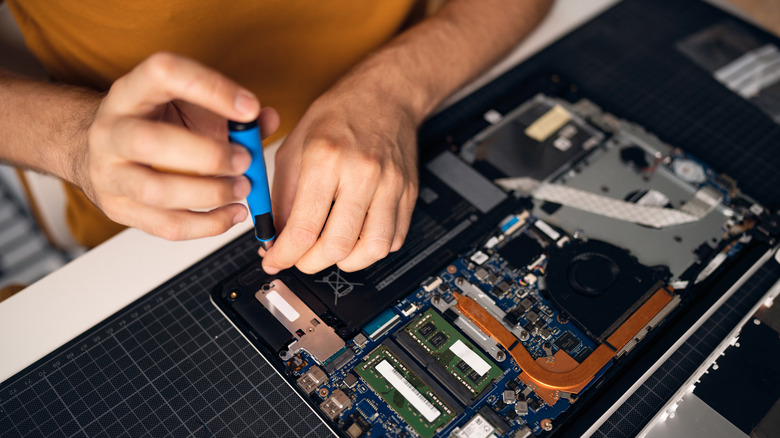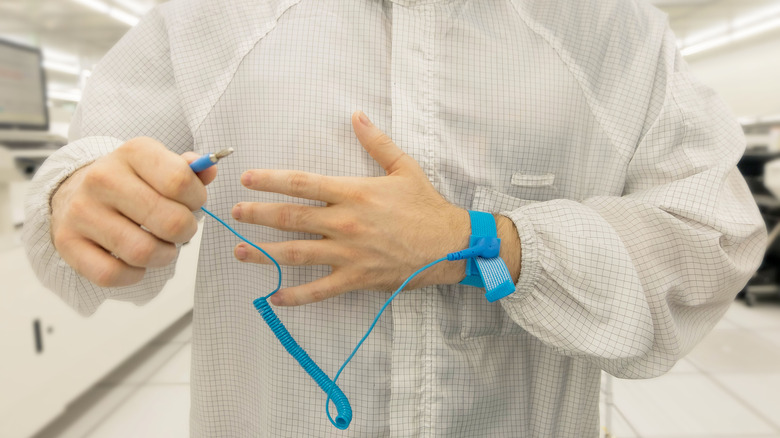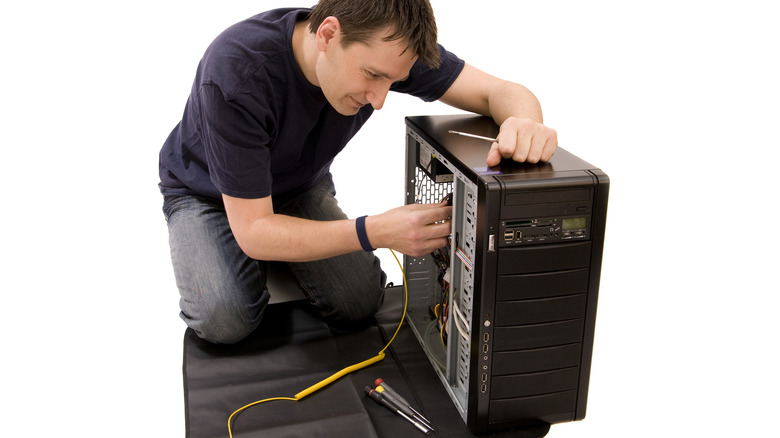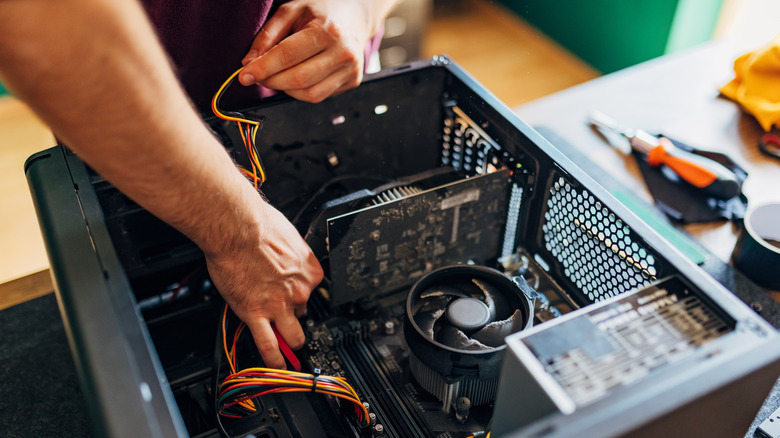How To Ground Yourself Before Touching Computer Components
Whether you're building a new computer from the ground up or replacing components in your Xbox, you'll need to ground yourself to prevent electrostatic discharge (ESD) from damaging your computer's sensitive internal parts. ESD happens when two electrically charged objects come into contact, causing a sudden flow of electricity. You may not even notice this happening while working on a computer; however, this discharge can be fatal to the sensitive electronic components in your PC.
We've all generated static electricity at one time or another. You may have experienced it when walking across a carpeted room or touching a plastic surface. While it may seem harmless, computer components, especially RAM, motherboards, and graphics cards, are highly susceptible to static damage. Even a small amount of static electricity can harm the parts of your PC, with the effects ranging from immediate failure to gradual degradation.
That's why grounding yourself before handling computer components is so important. By doing so, you ensure your body's electrical charge is balanced with the PC components you're working on; you'll also avoid shocking yourself, allowing you to complete your computer assembly or repair tasks safely.
Preparing your work environment
Before touching computer components, it's important to choose a suitable workspace to minimize the risk of ESD. The ideal workspace will be clean, free from clutter, and away from high-traffic areas to reduce the buildup of static electricity. You should avoid carpeted areas because they generate significant amounts of static.
There are several things you can do to ensure your work environment is static-free. Since dry air increases static buildup, you can purchase a humidifier to help control humidity and maintain optimal moisture levels in your workspace. Wearing clothes made of natural fibers instead of synthetic clothing can also help reduce static levels.
An anti-static mat can also help control static electricity while you're working. These mats give you a static-free surface to work on, and you can connect them to the ground to safely dissipate static charges, allowing you to tinker with your computer components without damaging them.
Wear an anti-static wrist strap
An anti-static wrist strap is an easy and convenient way to prevent ESD while building a PC or handling computer components. These straps are made up of a conductive band and dangling wire. All you have to do is wrap the band around your wrist and connect the wire to a grounding point. The strap works by balancing the electrical charge between you and the device you're working with, preventing static electricity from damaging the hardware.
Follow these steps to use an anti-static wrist strap:
- Wrap the anti-static wrist strap snugly around your wrist. It should be tight enough to stay in place but not so tight that it's uncomfortable.
- Make sure the metal plate on the strap is in direct contact with your skin to establish a good electrical connection.
- Find a grounding point to attach the strap's wire; this could be a grounded metal object or a designated grounding point.
- Connect the strap's wire to your chosen grounding point. Common options include the metal frame of the computer case or a grounding plug.
- Check the connection to ensure it's secure and the strap is still in proper contact with your skin.
- You're now ready to touch the computer components. The strap will continuously redirect the static electricity from your body to the ground.
You want to be sure you stay grounded throughout the time you spend working with the computer components. If you need to leave the workspace, disconnect the strap and reattach it when you're ready to start working again.
Use an anti-static mat
If you find wearing an anti-static wristband uncomfortable or simply want more freedom of movement while working with computer components, an anti-static mat can be an excellent choice. These mats provide a larger protective area against static electricity, so you can place multiple components on it while working without being tethered to a grounding point.
Anti-static mats are typically made of conductive materials and a grounded wire; some have a place to attach your anti-static mat in case you'd like to use both. When used on a work surface, they allow static electricity to flow away from computer components and into the ground.
Follow these steps to use an anti-static mat:
- Place the anti-static mat on a flat, stable surface where you plan to work on your computer components.
- Connect the mat to the ground by attaching the grounding wire to a grounded metal object or a dedicated grounding point in your work area.
- Place the computer components directly on the mat while you work.
- Avoid placing non-conductive materials between you and the mat while working.
- Periodically check to make sure your mat is properly connected to the ground.
Grounding to the computer case
Grounding yourself to the computer case is a simple and effective way to prevent ESD while working on computer components. You can do this by touching the metal part of your computer case to balance the static charge between your body and the computer parts.
This technique will only work if the computer case is conductive and grounded. A problem you may run into with this method is the fact that most modern computers are painted or coated, which can reduce their effectiveness in grounding static electricity. So, before you get started, you need to find an unpainted metal part of the case, such as a bare metal chassis or internal framework, for grounding.
Follow these steps to ground yourself to a computer case:
- Find an unpainted, conductive part of the computer case: a screw, the back panel, or any exposed metal area.
- Touch the metal part regularly before handling any sensitive components. Repeat this now and then while working to get rid of any static charge that may build up.
- Maintain contact with the metal part whenever possible. Some technicians like to rest part of their arm or hand on the case while working.
This method is especially useful when you don't have an anti-static wrist strap or mat. It's a quick and easy way to protect computer components from static damage. However, you should keep in mind that this technique is less reliable than a dedicated anti-static wrist strap or mat.




